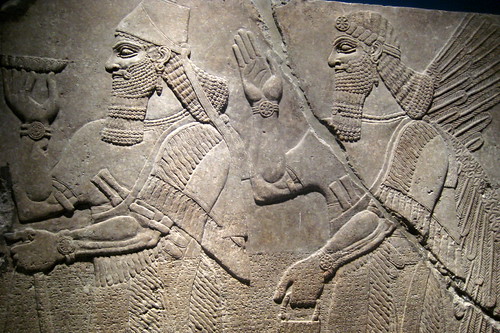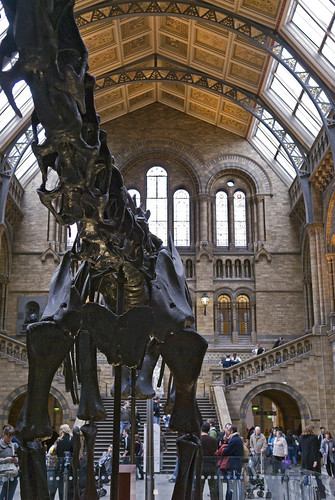A few nice Museums images I found:
NYC: Brooklyn Museum - Reliefs of King Ashur-nasir-pal II - King Ashur-nasir-Pal and a Winged Genie

Image by wallyg
King Ashur-nasir-pal and a Winged Genie
The Reliefs of King Ashur-nasir-pal II
From the palace of Ashur-nasir-pal II, Kalhu (modern Nimurd, Iraq), Room H of the Northwest Palace
Reign of Ashur-nasir-pal II (circa 883
King Ashur-nasir-pal and a Winged Genie
The Reliefs of King Ashur-nasir-pal II
From the palace of Ashur-nasir-pal II, Kalhu (modern Nimurd, Iraq), Room H of the Northwest Palace
Reign of Ashur-nasir-pal II (circa 883â€"859 B.C.)
Purchased with funds given by Hagop Kevorkian and the Kevorkian Foundation, 55.155
The twelve massive carved alabaster panels, on view together for the first time, that line the walls of the Hagop Kevorkian Gallery are but a sample of hundreds of such reliefs, all originally brightly painted, that once adorned the vast palace of King Ashur-nasir-pal II (883â€"859 B.C.), one of the greatest rulers of ancient Assyria. Completed in 879 B.C. at the site of Kalhu (modern Nimrud, slightly north of what is now Baghdad, Iraq), the palace was the heart of a vast empire.
The reliefs served a propagandistic purpose, proclaiming the king's legitimacy. Because most people in the Near East understood the administration of the state as a collaborative effort between the king and gods, many reliefs show the ruler and his supernatural attendants celebrating religious rituals. The most depict the ruler and his winged protectors (genies) tending a sacred tree.
Nearly all of the reliefs contain the same inscription. The script is cuneiform. The language is Akkadian. The text, known as the Standard Inscription, begins by tracing Ashur-nasir-pal II's lineage back three generations. It recounts his military victories, defines the boundaries of his empire, and tells how he founded Kalhu and built the palace.
In this relief, Ashur-nasir-pal II can be distinguished from his protective genies by the king's unique crown. The basic design is a low tapering cap resembling a modern Turkish fez; it represents the ruler as chief official of the kingdom. The spike projecting from the top symbolizes the king as warrior, and the broad sash wrapped around the crown reflects his elevated status in Assyrian society. Here the king is shown holding a bow and a hunter's bow. The bowl was used for offering libations; the bow and bowl together may refer to a hunting ritual. Archaeological excavations throughout the ancient Near East have revealed numerous examples of real bowls of this type in copper, bronze, silver and gold.
In 1840, a young English diplomat named Austen Henry Layard noticed an unusually large mound while rafting down the Tigris River. He returned in 1845 to unearth the remains of the palace, sending his discoveries to the British Museum in London. He sent so many monumental sculptures and relief-decorated slabs that the museum sold some of them, including these twelve reliefs. In 1855, the expatriate American Henry Stevens purchased the reliefs and shipped them to Boston. Unable to raise funds for the reliefs there, he sold them to James Lenox for the New-York Historical Society. In 1937, the Society lent them to the Brooklyn Museum and in 1955, Hagop Kevorkian, the New York collector and dealer, donated the funds to purchase and install the reliefs in the renamed Hagop Kevorkian Gallery of Ancient Middle Eastern Art at the Brooklyn Museum.
*
The Brooklyn Museum, sitting at the border of Prospect Heights and Crown Heights near Prospect Park, is the second largest art museum in New York City. Opened in 1897 under the leadership of Brooklyn Institute of Arts and Sciences president John B. Woodward, the 560,000-square foot, Beaux-Arts building houses a permanent collection including more than one-and-a-half million objects, from ancient Egyptian masterpieces to contemporary art.
The Brooklyn Museum was designated a landmark by the New York Landmarks Preservation Commission in 1966.
National Historic Register #770009
Natural History Museum

Image by Prodromos Sarigianis
After the V&A we decided to drop in to the Natural History Museum down the road just for a minute before going home. The official excuse was that Nikolas would like to see the dinosaur (again, he has been there a few times), but really I just wanted a few more photos:-) A couple more shots in the comments. I actually like this crop but I still want a wider lens... as well as that tilt-shift. Need to remember to buy that lottery ticket.
Thanks for the visit, comments & faves - have a great week!
Come Closer (if you dare)
Other posts like this, by keyword:
Brooklyn:
Museum:
Tops: Building and Experimenting with Spinning Toys (Boston Children’s Museum Activity Book) ...
American Art of the Twentieth Century: Treasures of the Whitney Museum of American Art (Tiny Folio) ...
Thornton W. Burgess Society Green Briar Nature Center, Jam Kitchen and Museum ...
Artwise Paris Museum Map – Laminated Museum Map of Paris, FR ...
The Strange Museum: Pirate’s Revenge ...
ROM (Royal Ontario Museum) ...
European Paintings in the Toledo Museum of Art ...
Raqqa Revisited: Ceramics of Ayyubid Syria (Metropolitan Museum of Art Series) ...
Brothel to see new action as museum ...
Rooms with a View: The Open Window in the 19th Century (Metropolitan Museum of Art) ...
King:
Build Your Own Bunk Bed DIY Plans for Twin FULL Queen or KING sizes Adult or Child So Easy, Beginners Look Like Experts; PDF Download Versio ...
Kirby: King of Comics ...
The Science of Stephen King: From Carrie to Cell, The Terrifying Truth Behind the Horror Master’s Fiction ...
Gene King Talks About Social Media at Michigan Municipal League Event ...
Winged:
Reliefs:
Genie:
IT Governance: How to Control the IT Genie, Provide Transparency and Avoid a Corporate Horror-Story in Your Organization (Thorogood Reports) ...
Ashurnasirpal:
No comments:
Post a Comment